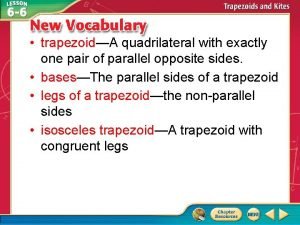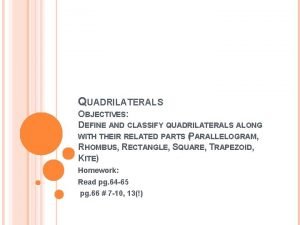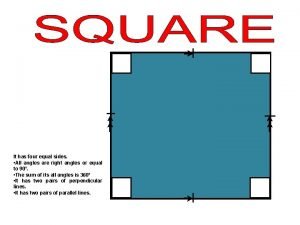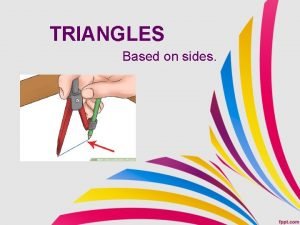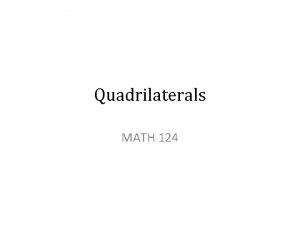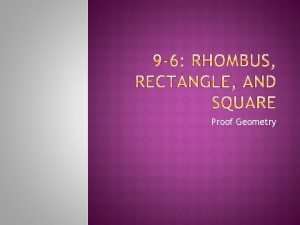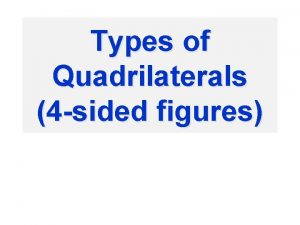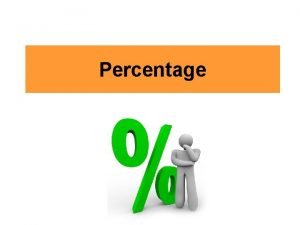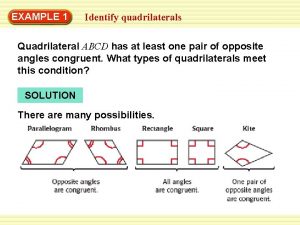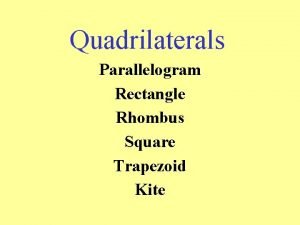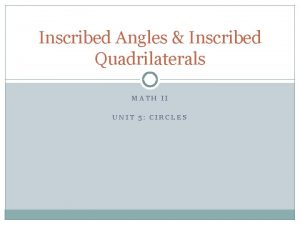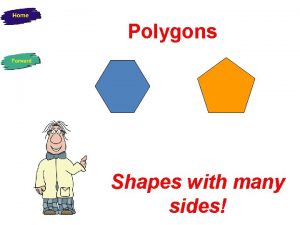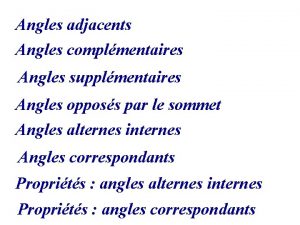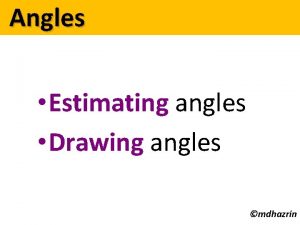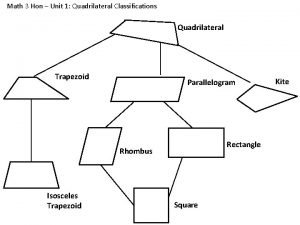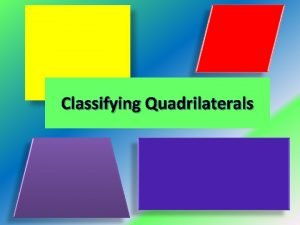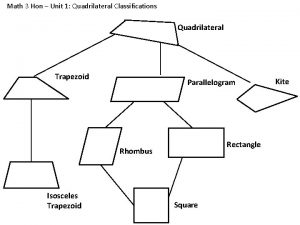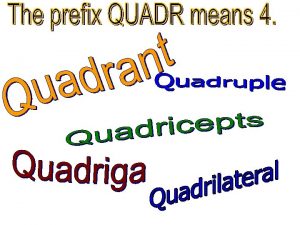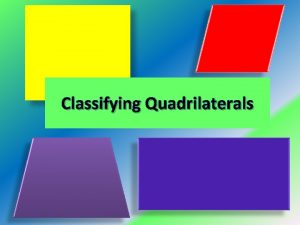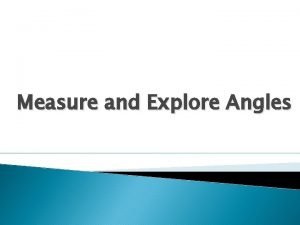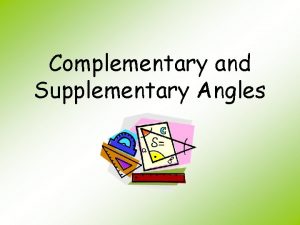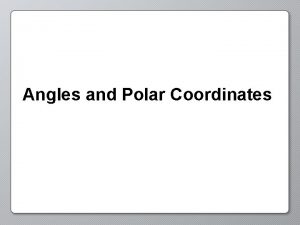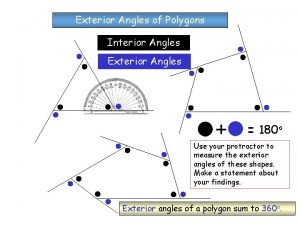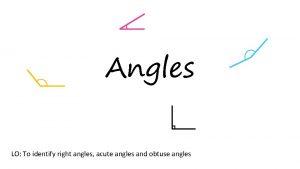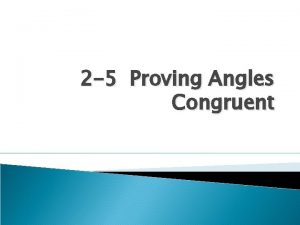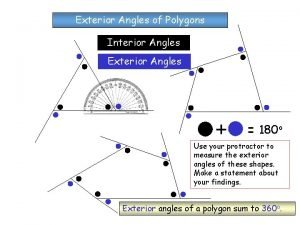Quadrilateral I have exactly four sides and angles




















- Slides: 20


*Quadrilateral I have exactly four sides and angles. If you add all of my angles together, then you would have 3600

*Trapezoid I have only one set of parallel sides.

*Parallelogram I have: - 2 sets of parallel sides - 2 sets of congruent sides - opposite angles congruent - consecutive angles supplementary


*Rectangle I have all of the properties of the parallelogram PLUS - 4 right angles

*Rhombus I have all of the properties of the parallelogram PLUS - 4 congruent sides

*Square Hey, look at me! I have all of the properties of the parallelogram AND the rectangle AND the rhombus. I have it all!

Examples

3. If one angle of a parallelogram is 60 degrees, find the number of degrees in the remaining 3 angles. 1 2 3

3. If one angle of a parallelogram is 60 degrees, find the number of degrees in the remaining 3 angles. 1 2 3 Since consecutive angles are supplementary, angle 1 and 600 must add up to 1800. Angle 2 is opposite of 600, therefore angle to is equal to 600. Angle 3 is opposite of angle 1, therefore angle 1 and angle 3 are congruent.

3. If one angle of a parallelogram is 60 degrees, find the number of degrees in the remaining 3 angles. 1 2 3 Since consecutive angles are supplementary, angle 1 and 600 must add up to 1800. Angle 2 is opposite of 600, therefore angle to is equal to 600. Angle 3 is opposite of angle 1, therefore angle 1 and angle 3 are congruent. Angle 1 = 1200 Angle 2 = 600 Angle 3 = 1200

4. Find the number of degrees of each angle in the quadrilateral. x 2 x

4. Find the number of degrees of each angle in the quadrilateral. x 2 x All quadrilaterals have 3600. So, x + 2 x = 360 6 x = 360 x = 60

4. Find the number of degrees of each angle in the quadrilateral. B C x A 2 x All quadrilaterals have 3600. So, x + 2 x = 360 6 x = 360 x = 60 x 2 x D Angle A = 1200 Angle B = 600 Angle C = 600 Angle D = 1200

Practice Problems

Which statements describe the properties of a trapezoid? a. b. c. d. The bases are parallel. The diagonals are congruent. The opposite angles are congruent. The base angles are congruent.

Which statements describe the properties of a rhombus? a. b. c. d. The diagonals are perpendicular. The diagonals are congruent. The diagonals bisect each other. The diagonals bisect the angles.

If one angle of a parallelogram is 60 degrees, find the number of degrees in the remaining 3 angles.

In rhombus MATH, MA = y + 8 and AT = 4 y - 7. Find MA.
 Quadrilateral with exactly one pair of parallel sides
Quadrilateral with exactly one pair of parallel sides A quadrilateral with two pairs of parallel sides
A quadrilateral with two pairs of parallel sides A has four equal sides
A has four equal sides Vertical angles shapes
Vertical angles shapes Shapes with straight sides
Shapes with straight sides All equilateral triangles are acute true or false
All equilateral triangles are acute true or false Do all quadrilaterals have four sides
Do all quadrilaterals have four sides Def of rectangle
Def of rectangle 4 sided figures
4 sided figures Quadrilateral family tree
Quadrilateral family tree Quadrilateral image
Quadrilateral image Quadrilateral abcd has all congruent sides
Quadrilateral abcd has all congruent sides Plane of symmetry of triangular prism
Plane of symmetry of triangular prism Zoological riddles challenge
Zoological riddles challenge Obtuse
Obtuse Is a square a rhombus
Is a square a rhombus Angles in inscribed quadrilaterals
Angles in inscribed quadrilaterals Name quadrilaterals worksheet
Name quadrilaterals worksheet What shape has 2 parallel sides and no right angles
What shape has 2 parallel sides and no right angles A polygon with six congruent sides and six congruent angles
A polygon with six congruent sides and six congruent angles 2 dimensional shapes that have 8 angles
2 dimensional shapes that have 8 angles
